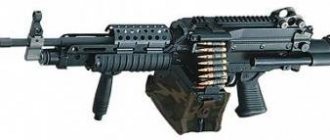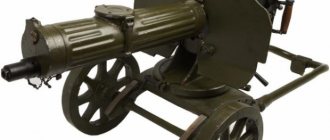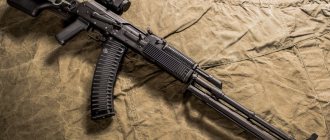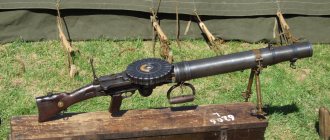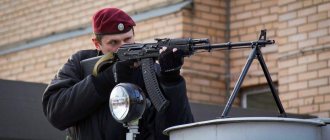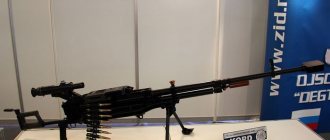USA
Browning M1919 machine gun
The M1919A4 was produced mainly for infantry and proved to be a first-class heavy machine gun, with a high rate of fire and without any particular complaints or problems. The tank version was designated M1919A5; the M2 modification was developed for the Air Force (installed on both fighters and bombers - on turrets).
The US Navy received the AN-M2 machine gun, developed on the basis of the M1919A4. Thus, over the long production period, many modifications and production changes appeared, but the basic design of the M1919 remained unchanged. The cartridges were fed using a cloth or metal tape. In the infantry, a machine gun was usually mounted on a simple tripod machine, but there were a great variety of machines, including quite complex ones for anti-aircraft installations and simple mounts for installation on various types of wheeled vehicles.
Light machine gun
Perhaps the strangest modification of the M1919 was the M1919A6. It was designed as a light machine gun to enhance squad firepower to replace the BAR machine gun. This model was introduced in 1943 and was an M191A4 with a strange shoulder rest, bipod, carrying handle and a lightweight barrel. The result was a machine gun that was quite heavy for a hand gun, but easy to manufacture.
The disadvantages were the general awkwardness of the weapon and the need to use gloves to change the barrel. Despite this, the M1919 was produced in large quantities (a total of 43,479 units were produced). The troops were forced to use it, realizing that it copes with its task better than BAR. The main value of all models of this machine gun was its reliability: they remained operational even in the most unfavorable conditions, when almost all other models (except, perhaps, the Vickers) failed.
Browning M1919 machine gun characteristics:
- Browning M1919A4 machine gun
- Caliber - 7.62 mm
- Weight: 14.06 kg
- Overall length: 1041 mm
- Barrel length: 610 mm
- Initial bullet speed: 854 m/s
- Rate of fire: 400 - 500 rounds/min
- Food: fabric or metal tape, 250 rounds
Browning M1919A6 machine gun
- Caliber: 7.62 mm
- Weight: 14.74 kg
- Overall length: 1346 mm
- Barrel length: 610 mm
- Initial bullet speed: 854 m/s
- Rate of fire: 400 - 500 rounds. /min
- Food: fabric or metal tape, 250 rounds
https://youtube.com/watch?v=pOP-pcl-XUY
Description of design
The automatic operation of the Bren light machine gun is based on the removal of powder gases from the barrel bore. The gas outlet cylinder is located under the barrel and has an adjustable diameter of the channel opening. The regulator has four positions.
The piston stroke is long. The barrel bore is locked by tilting the bolt. The trigger mechanism allows both automatic and single fire.
The Bran machine gun has a replaceable air-cooled barrel, which is attached to the receiver with a bolt-threaded connection. It only takes seven seconds to change the barrel. To avoid hand burns when changing the barrel, it was equipped with a wooden handle, which was also used when carrying the weapon.
Feeding is done from a sector-shaped box magazine with a capacity of 30 rounds, placed on top. When the magazine is removed, the receiver window is locked with a special cover, which is secured with a magazine latch. The cartridge cases are extracted downwards. The first modification of the machine gun (Mk.1) used a disk magazine with a capacity of 100 rounds, but it was later abandoned due to the high price and lack of reliability.
Because of the rim on the cartridge case, the cartridge was often warped, so soldiers were recommended to equip the magazine with 27-28 rather than 30 rounds.
On the left above the pistol grip there is a fire mode selector with 3 positions: single fire, automatic fire and safety.
Because the machine gun magazine was installed on top, the sights were shifted to the left. The sight is diopter, sector type, with a range from 200 to 2000 yards (50 yard increments).
The machine gun was equipped with folding bipods, which were attached to a gas cylinder. The butt of the machine gun had a special butt pad, which reduced recoil when firing. The Bren could be mounted on a special tripod and used as an anti-aircraft machine gun.
The advantages of the Bren light machine gun include its simplicity, reliability, and highest shooting accuracy.
If we talk about the shortcomings of “Bran”, then we can point out the following points:
- low rate of fire;
- frequent misalignment of cartridges due to a not very successful cartridge;
- very small magazine capacity;
- the store located on top limited the machine gunner's view.
It should also be added that the Bren was quite difficult to manufacture and expensive; the machine gun contained a huge number of milled parts.
Notes
- Contre les Mau Mau, Encyclopédie des armes: Les forces armées du monde
, vol. XII, Atlas, 1986, pp. 2764–2766
- ↑ . ofbindia.gov.in
. - Report of the head of the 5th department of the BTU GABTU KA to the head of the department for acceptance of imported weapons of the TU GBTU KA 01/06/1945 on design changes in the Canadian tank "Valentine"
- Windrow, Martin.
The Algerian War, 1954-62 (unspecified). - London: Osprey Publishing, 1997. - P. 9. - (Men-at Arms 312). — ISBN 978-1-85532-658-3. - . www.awm.gov.au.
_ Retrieved July 4, 2022. - ↑ Jane's Infantry Weapons 2009/2010 (unspecified) / Jones, Richard D.; Ness, Leland S.. - 35th. - Coulsdon: Jane's Information Group, 2009. - ISBN 978-0-7106-2869-5.
- , p. 212.
- Jowett, Philip.
Modern African Wars (5): The Nigerian-Biafran War 1967-70 (English). - Oxford: Osprey Publishing Press, 2016. - P. 23. - ISBN 978-1472816092. - (Czech). vhu.cz.
_ cs (English). - , p. 285.
- Lart, Bernard
.
lavoiedelepee.blogspot.com
(September 19, 2015). - . sites.google.com
. Retrieved July 4, 2022. - . Web.archive.org
(March 16, 2014). Retrieved July 4, 2022. - , p. 52.
- ↑, p. 24.
- , p. 6.
- , pp. 22&24.
- , pp. 293&296.
- . oldbritishguns.com
(25 February 2011). - , p. 337.
- , p. 613.
- , p. 372.
- Robert Asprey.
War In The Shadows: The Guerrilla in History. - 2002. - P. 320. - ISBN 978-0595225934. - Michel Germain.
Histoire de la Milice et des forces du maintien de l'ordre en Haute-Savoie 1940–1945: Guerre civile en Haute-Savoie (French). - 1998. - P. 144. - ↑ Windrow, Martin.
The French Indochina War 1946–54 (undefined). - Osprey Publishing, 1998. - P. 41. - (Men-at-Arms 322). — ISBN 9781855327894. - , p. 450.
- . Wwiiafterwwii.wordpress.com
(October 18, 2015). Retrieved July 4, 2022. - ↑, p. 66.
- , p. 461.
- ↑, p. 65.
- , p. 64.
- , p. 498.
- so, 240 pcs. Machine guns of this type captured in Singapore in 1942 were transferred to the troops after the surrender of the English garrison. Report of installations and captured weapons, Java and Singapore 1942. Prepared by Headquarters USAFFE and Eighth US Army (rear). 1958. page 65
- Young, Peter.
The Arab Legion (undefined). - Osprey Publishing, 1972. - P. 24. - (Men-at-Arms). — ISBN 978-0-85045-084-2. - , p. 26.
- New Zealand House of Representatives.
// Parliamentary Debates (undefined). - 1968. - P. 554. - .
- Charles Whiting.
Siegfried: The Nazis' Last Stand (unspecified). - Cooper Square Press (English) Russian, 2001. - P. 181. - ISBN 978-0815411666. - , p. 521.
- Cregeen, Phil
(November 14, 2013). - , p. 20.
- , p. 523.
- Alpers, Philip.
The Politics of Destroying Surplus Small Arms: Inconspicuous Disarmament (English) / Karp, Aaron. - Abingdon-on-Thames: Routledge Books, 2010. - P. 168-169. — ISBN 978-0-415-49461-8. - Zaloga, Steven J.
The Polish Army 1939–45 (unspecified). - Osprey Publishing, 1982. - P. 29, 36. - (Men-at-Arms 117). — ISBN 9780850454178. - , p. 530.
- Grant, Neil.
Rhodesian Light Infantryman: 1961–1980 (unspecified). - Osprey Publishing, 2015. - P. 13. - ISBN 978-1472809629. - (2013).
- Error in footnotes?: Invalid tag; no text provided for footnotes
- Shaw, Alan
.
BBC WW2 People's War
(11 November 2004). - . Wwiiafterwwii.wordpress.com
(November 24, 2017). Retrieved July 4, 2022. - Capie, David.
Under the Gun: The Small Arms Challenge in the Pacific. - Wellington: Victoria University Press (English) Russian, 2004. - P. 68-69. — ISBN 978-0864734532. - , p. 24.
- . wwiiafterwwii.wordpress.com
(September 9, 2018).Template:Better source - .
- , p. 43.
World War II production
"Ronnie the Bren Gun Girl", posing with finished product at the John Inglis plant, Toronto, 1941
- RSAF Enfield, UK: 400 per month.
- John Inglis and Company, Canada: A contract was signed with the British and Canadian governments in March 1938 to supply 5,000 Bren machine guns to the UK and 7,000 Bren machine guns to Canada. Both countries share the capital costs of bringing in a new production facility. Production began in 1940, and by 1943 Inglis produced 60% of the world's production of Bren machine guns.
- Long Branch, Toronto, Canada.
- Ishapore, India.
- Lithium weapons plant, Australia.
The history of the creation of the Bran light machine gun
The history of the Bren light machine gun began in 1930, when the British War Department decided to hold a competition for a new light machine gun chambered for .303 ammunition. It was supposed to replace the clearly outdated Lewis and Hotchkiss machine guns.
The British military attaché in the Czech Republic sent positive reviews about the Czech ZB-30 Zbroevka Brno machine gun and recommended that the commission pay attention to it. This light machine gun was included in the competition last, but in the first round of selection it showed excellent results, after which the British ordered its version chambered for .303 in Brno
A number of improvements and changes were made to the design of the weapon; in May 1935, an agreement was signed between the Czech and British governments to begin licensed production of these weapons. The fine-tuning of the machine gun was carried out at the famous arms factory in Enfield and dragged on until 1937. The light machine gun received a name made up of the first syllables of two cities: BRno-ENfield - Bren.
The main differences between the Bran machine gun and the ZB-30 are related to the characteristics of the English ammunition. The .303 cartridge had rims, but the Mauser cartridge did not.
By the way, the Czechs continued to produce the ZB-30 light machine gun chambered for the 7.92 mm Mauser cartridge. They supplied these weapons to their national army, as well as to Lithuania and Bulgaria.
The Bren machine gun was adopted for service in August 1938. The first modification was called Mk 1. The machine gun had a shoulder support and an additional handle, which were later abandoned. Large-scale production of weapons began only the following year, after Hitler's attack on Poland.
In 1940, the machine gun began to be supplied to the troops in large quantities; by mid-1940, there were more than 40 thousand units of this weapon in the British army. A lot of machine guns were lost after the battle of Dunkirk. The British could not make up for the losses on their own, so Bren production began in Canada. In 1943, the Canadian company John Inglis and Company produced 60% of all Bran machine guns produced.
During the war, several modifications of this weapon were created (Bren Mk.2 - Bren Mk.4). The designers sought to make the machine gun simpler and cheaper.
After the war and England's transition to the NATO 7.62 mm cartridge, most of the machine guns were also converted to use this ammunition; these machine guns received the designation L4A1 - L4A6.
Machine guns BREN Mk. I, Mk. II, Mk. III, Mk. V
Bren is an English light machine gun, a modification of the Czechoslovak ZB-26 machine gun. Post-war modifications of the Branes are still in use today.
History of creation and production
Back in the mid-20s, the military leadership of Great Britain announced a competition for a machine gun that was supposed to replace the heavy Lewis, but none of the presented British, French, Danish, Czech and Swiss systems was chosen. In the 1932 tests, the Vickers-Berthier took first place, but the new machine gun was intended to replace the mounted Vickers Mk. I, and a manual Lewis, but the Vickers-Berthier could not satisfy the requirement of intensive firing from the machine, so it came into service only with Indian units.
The last to be included in the competition among the participants was the 7.92-mm Czech-made ZB-30 machine gun, added for testing at the insistence of the British military attaché in Czechoslovakia. a version chambered for the English .303 British cartridge, known as ZGB-30 Brno plant . A number of test stages and a number of improvements followed, resulting in the appearance of variants of the ZGB-33 and ZGB-34 .
In May 1935, the company Česka Zbrojovka and the British government signed an agreement on the licensed production of a machine gun in the city of Enfield at the Royal Small Arms Factory . Serial production of a new machine gun, named after the cities of Brno and Enfield ( Br
no and
En
field), was deployed in 1937.
In August 1938, the first modification, designated Mk, was put into service. I. _ Mass production was established in 1939, after the German attack on Poland, production was increased to 400 pieces per week. By June 1940, the army had more than 30 thousand machine guns of the first model.
An English soldier practices firing a Bren Mk machine gun. I
Production of the Bren Mk machine gun. I was metal-intensive and technologically complex. For the production of the receiver alone, about 550 measurements and 270 operations were necessary, and a part weighing up to 2 kilograms was obtained from a workpiece weighing 10 kilograms - for wartime, such metal losses were very sensitive.
In this regard, the Bren Mk. adopted in June 1941 . II was notable for speeding up and simplifying production.
The Royal Small Arms Factory tried very hard to increase production, by 1943 it was brought to the level of 1,000 machine guns per week, so the production of Bren machine guns was also launched in Canada at the John Inglis and Company and in Australia at the Lithgow Small Arms Factory .

